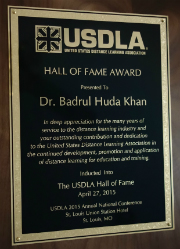According to Badrul Khan:
The seeds for the e-learning framework began germinating with the question, “What does it take to provide flexible learning environments for learners worldwide?” After the publication of Web-Based Instruction (Khan, 1997), readers began e-mailing me to ask whether I could point them to a Web-based course that I thought was truly Web-based instruction, as I defined it in the book. Unfortunately, I didn’t have an answer for them. In 1997, the Web was used more for presenting information than for designing instruction; people were still experimenting with the Web. However, the rapid growth of e-learning over the next few years provided a rich climate for further exploration of this question.
Since then, I have communicated with learners, instructors, administrators, and technical and other support services staff involved in e-learning (in both academic and corporate settings) all over the world. I have researched e-learning issues discussed in professional discussion forums, and I have designed and taught online courses. Also, as the editor of Web-Based Training (2001b) and the forthcoming Web-Based Learning (in press), I had the opportunity to work closely on critical e-learning issues with more than 100 authors worldwide who contributed chapters to these books.
Through these activities, I learned that e-learning represents a paradigm shift not only for learners, but also for instructors, administrators, technical and other support services staff, and the institution. We are accustomed to the structure of a traditional educational system where instructor-led, face-to-face classes are part of the learning environment. e-Learning, on the other hand, is an innovative way of providing instruction to diverse learners in an environment where students, instructors, and support staff do not see each other. The format of such a learning environment is different than traditional classroom-based instruction. The latter takes place in aclosed system (i.e., within the confines of a given classroom, school, textbook, or field trip), whereas e-learning takes place in an open system (i.e., it extends the boundaries of learning to an open and flexible format where learners decide where and when they want to learn).
As we are accustomed to teaching and learning in a closed system, the openness of e-learning is new to us. To create effective e-learning environments for diverse learners, we need to jump out of our closed system mentality. We need to change our mindset– that’s the paradigm shift. In order to facilitate such a shift, and in response to the range of issues I saw in my research, I created a framework for e-learning .


